The cover to Guy Delisle’s Jerusalem shows him sitting at the edge of a Muslim cemetery on the Mount of Olives facing the Golden Gate, the gate through which the Messiah is expected to enter the Holy City. One could see this image as a conjunction of faiths and a metaphor for all that Delisle encounters: the Palestinians (Muslims and Christians) in their graves; the door closed to any true understanding of the situation; the cartoonist sketching furiously in the foreground; all of them awaiting salvation.
Delisle presents himself as a blank slate, as devoid of any information as the doodle with which he represents himself; a surprise considering his comic travelogues through Shenzhen, Burma, and Pyongyang. At one point he even seems perplexed that while Israel and many of its citizens view Jerusalem as the capital, most countries only accord Tel Aviv that honor and situate their embassies accordingly. It’s almost as if television, the internet, and the Arab-Israeli wars had never occurred. In many ways, he’s like the guy sitting next to you on your bus tour of Israel, the one who knows next to nothing about the place he is visiting. Unlike most tourists, he has months to rectify his ignorance. How one feels about this is a matter of perspective and depends on what we expect from a reading experience.
The intention one suspects is to allow both Delisle and his readers to set off on a journey of discovery together—no back tracking, no overarching narrative omniscience, no real meaning—the gentle meandering rhythms of expatriate life distilled to several semi-significant and ordinary moments in time. The idea here being that what best signifies any city (even Jerusalem) is not its monuments, its festivals, or its tragedies (though these are give some space) but its commonness; the quotidian lives of its citizens—the parties, the daycare hang-ups, the shawarma encounter, the transportation stories, and the amusing anecdotes about Arab women. In place of discernment, Delisle offers affirmation and comfort, a year in the life of a cartoonist house husband whose partner is working with Médecins Sans Frontières (MSF). What little information we get is conveyed at a slow pace and is quite disconnected, taking on the fabric of directly recorded experience with little heed to the editorial mindset. It is very much an unvarnished journal comic, certainly not a guided tour or an essay much less an encyclopedic account on specific areas of interest. The author’s prose style, cultivated through years of travel writing, is plainer than his drawings: short, unpoetic, and unexamined.
His first substantial political encounter comes 38 pages in (there are a number of minor instances before this) when he visits a border crossing and the West Bank barrier with Machsomwatch, an Israeli women’s peace movement. At the crossing, the crowd is large and slow moving, the Israeli guards fully armed for war and happy to allow their pictures to be taken. Almost inevitably, there is a misunderstanding and then tear gas and stone throwing. In attendance, the television crews and Delisle; both hopping on the same media treadmill (their’s faster, his slower) we’ve seen re-enacted over the years; the artist’s eye paralyzed, the reader’s mind and emotions unengaged—the bulk of these experiences freely available all year around to the tourist looking to cross from an Arab country into Israel. It made me wonder why he didn’t visit the duty free shop while he was there (I guess there wasn’t one at the crossing).
To be sure, Delisle is not opposed to painting himself in a bad light. His reaction to the arrival of his cleaning lady is irritation as she tips his blog creating activities into disarray. He throws a small tantrum and makes a frustrated phone call to his wife.
The comic under review is of course that “blog” or rather the result of that year of engagement; conveying all the daily grind of perpetual enforced communication in a tone strangely shy yet smug.
Jerusalem works best when Delisle’s art meshes with his subject matter in the kind of light social observation you find in his earlier comic, Aline et les autres. The denouement of his hunt for the perfect bowl of cereal ends to sort of interesting effect when he sees bag-laden “Muslim women” leaving the settlement supermarket he has chosen to boycott.
There’s a little homily in a playground about mothers, children, and racial harmony (I grant that the reader’s cynicism will need to be checked in at the point of purchase).
There’s the part where he compares an “all-male” Arab wedding to a comics festival…
…and also some girls in bikinis with a hookah.
His embarrassment and exaggerated spinelessness can also be charming at times.
Most of it, however, reminds me of a photo album with commentary, the kind of ritual myth making experienced when a friend returns from his travels. A tale of gold-lined domes made on the backs of mercury poisoned death row prisoners is tucked in, as is his displeasure with a Zionistic Israeli tour guide (recognizable at least). And as with all such tales, there will be the travel disasters to punctuate the proceedings. In the case of Delisle, the multitude of El Al-related airport hassles and a lengthy sequence concerning the loss of some car keys down a lift shaft. Always amusing when the canapes are being served. The only problem being that Delisle isn’t your friend, and you’re not terribly interested in his family life and travel pics. Unless of course you are, in which case Jerusalem and his many other comics might be just what you’re looking for.
Even so, the reader is advised in advance that this is not a book to be read all at once, the banality of the insights here engendering feelings similar to those encountered when reading a large collection of cartoon dailies in one sitting. The off-days on the strip accumulate, its charms disappear, the limitations in drawing style are accentuated, the anonymity of the locales depicted become obvious, the jokes fall flat, life in all its disjointedness and directionless comes to the fore. Delisle has a dogged commitment to this aesthetic even taking time to relate how he fails to complete a visit to the three holy places of Jerusalem (the Church of the Holy Sepulchre, the Western Wall and the Temple Mount).
His ploy to get through by pretending to be a Muslim is not entirely without credit but there it stops. He neither speaks to these people at length nor inquires into the situation. The lack of curiosity is patent, the superficiality immense. There are short returns later in the comic but to little effect. The Holy Sepulchre is precisely what every oblivious tourist sees—the famous balcony ladder, the Orthodox-Catholic division of space in the church, the photo mad crowds (though strangely none of the religious fervor)—as short and indescript as a one line summary and just as educational.
Not surprisingly, the religious naiveté on display beggars belief. Ten months into his trip and Delisle still has to be told what a Messianic Jew is (perhaps its an act of pretense to encourage conversation). And did it really take him that long to find out that merchants rent out crosses for pilgrims wishing to traverse the Via Dolorosa (there are sometimes stacks of them near the Holy Sepulchre)? Earlier in his comic, a sectarian fight in the church seen on television is a moment for hand wringing and a lame joke, not dissection or historical analysis:
Perhaps Delisle isn’t talking about the same religion which sanctioned the sack of Jerusalem during the first Crusade. Could it be some other sect that has been living under the Status Quo for over a century and which continues to see brawls and property disputes on a yearly basis? Apart from this, there’s a frankly emaciated discussion with a member of the Franciscan order and a couple of prods at dispensational fundamentalists clearly meant as comic relief. Good for a polite guffaw provided one hasn’t heard the same joke done even once before.
There are occasional reprieves from this rampant shallowness. The author’s recurrent trips to Hebron are of some interest, in particular his guided tour with Breaking the Silence.
Delisle can be heavy-handed in his juxtapositions but, to his credit, never descends to the level of crass exploitation. The observations in Mea Shearim are also reasonably sharp considering the episode lasts only 4 pages. Most of these vignettes occur towards the tail end of the book and there’s little doubt that Delisle’s narrative improves as soon as he runs out of the usual things to say.
The rest of the long aimless middle section is almost too painful to relate. The return to the Temple Mount with a picture of the Dome of the Rock is of less interest than the most token tourist photo (the Al Aqsa mosque gets slightly better mileage).
Delisle’s depiction of a Samaritan Easter (Passover) celebration on Mount Gerizim only makes us yearn for a proper photojournalistic account. The picture post card trail to Bethlehem, Massada, the Dead Sea, and Jordan is little better.
Delisle’s shtick is to tease out truth from the commonplace. He never does what you would never do in the same situation, hardly thinks an improper thought and almost never tells you anything which you don’t know yourself. Jerusalem is the playground viewed absentmindedly for a moment through your house window, as innocuous as people dying on a television screen—never close, never real, no scars, no blood, and never painful. Seldom does Delisle push pass this point. An instance of this occurs at the moment of departure when his housekeeper tells him that her house is about to be demolished. The episode is only two pages long but for once, it’s personal.
The graph which Delisle’s produces mid way through his depiction of a Gaza bombing campaign (a central event in his journal comic) is eerily representative of much his delivery. The prose apeing the art in a consistent blank drone with neither the vocabulary nor technique to elevate the text. His pedestrian interview with Cecile is as close to fine journalism as he gets, the 10 year veteran of MSF dissolving into an insignificant collection of lines and shade spouting words from the left border of each panel. Some will see this sequence as an attempt to let the words speak for themselves. In which case, I must ask, why comics?
The narrative’s positioning in the arena of the trivial and everyday is no excuse for poor art. Consider the following amateur photography project by Still Yang. A simple set-up with a long zoom facing a bus stop situated in a Jewish orthodox community; the shots taken at the discretion of the photographer. The truth is that I found more humanity and insight in this simple project than much of Delisle’s comic. At the other end of the spectrum, there’s something like Simon Sebag Montefiore’s Jerusalem: The Biography—written in an entertaining style but with immense erudition and an all encompassing but popular intent. It begins with mythical history and ends on any morning at 4am in Jerusalem: the rabbi of the Western Wall at his prayers; Nusseibeh, the Custodian of the Holy Sepulchre knocking on those “ancient doors”; the Ansari Custodians of the Haram supervising the opening of the gates of the Dome of the Rock and al-Aqsa.
Guy Delisle’s Jerusalem has neither the concentration nor sweep of the art and ephemera which have preceded it. The cracks in the artist’s craft were hidden in his adaptation of Pyongyang, the rigidity, the stunted acumen, the plodding pace, the bland discursions all feeding and reinforcing received conceptions of an authoritarian North Korea. These flaws are laid bare in Jerusalem which is morally earnest but sadly leaden and inconsequential.
Further Reading
Noah Berlatsky on the vaunting tedium of Guy Delisle’s Jerusalem
David Leach’s review is my token “positive” inclusion if only because he goes into detail about what he likes. He praises Delisle’s use of the anecdotal story form and singles out the chapter on Ramallah for praise.
S. I. Rosenbaum on Delisle’s political and social obliviousness.
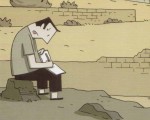
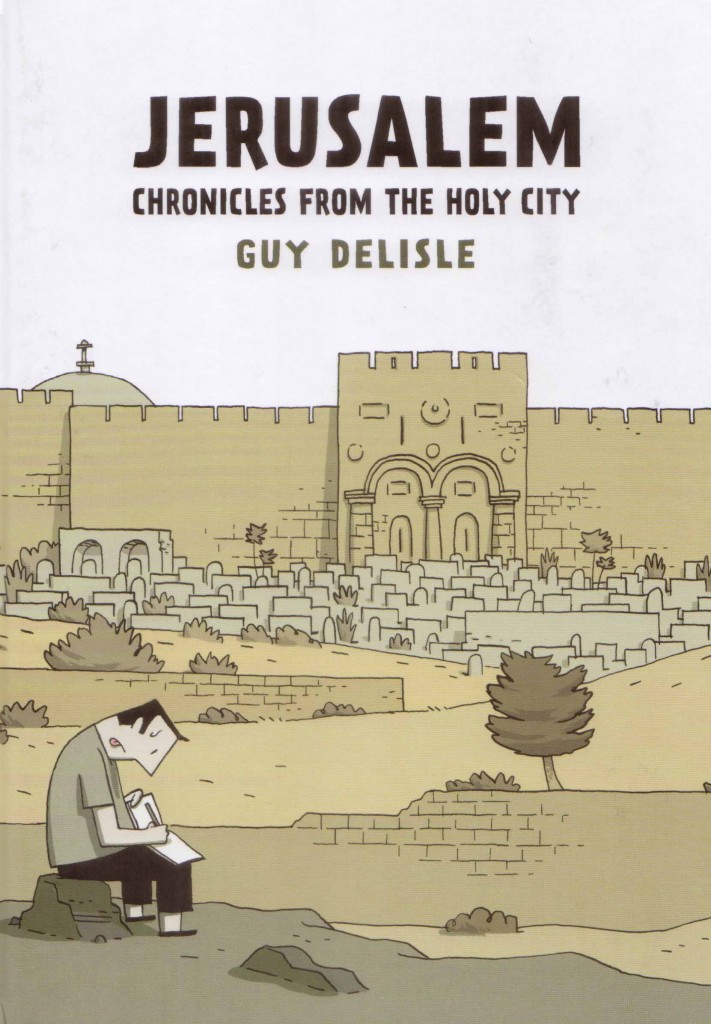
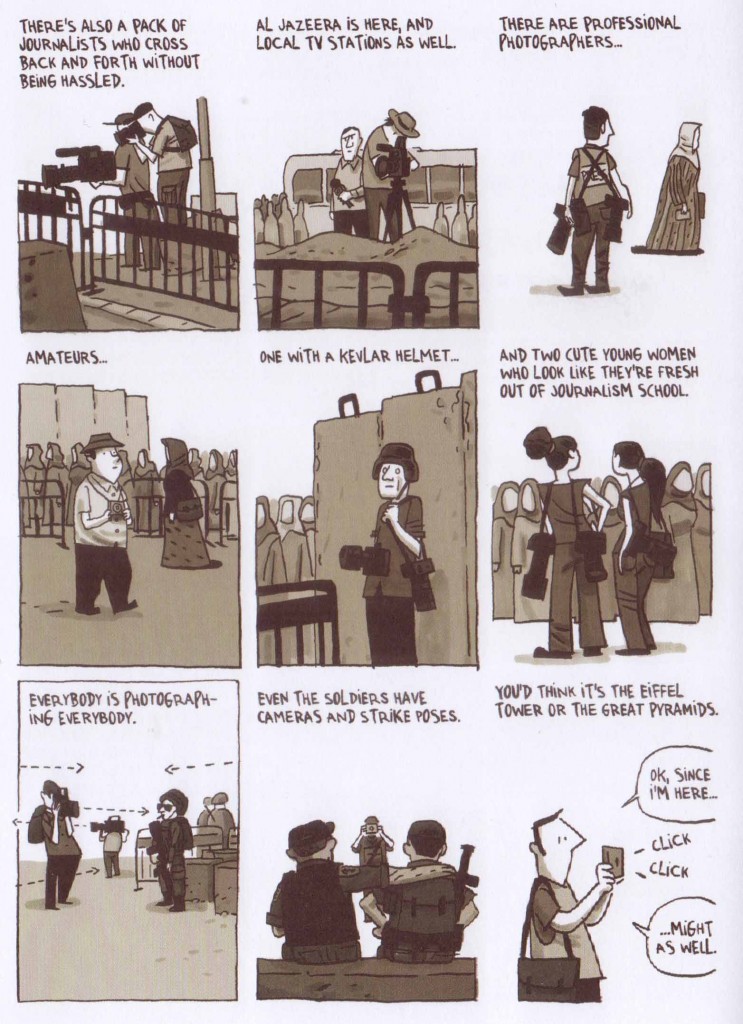
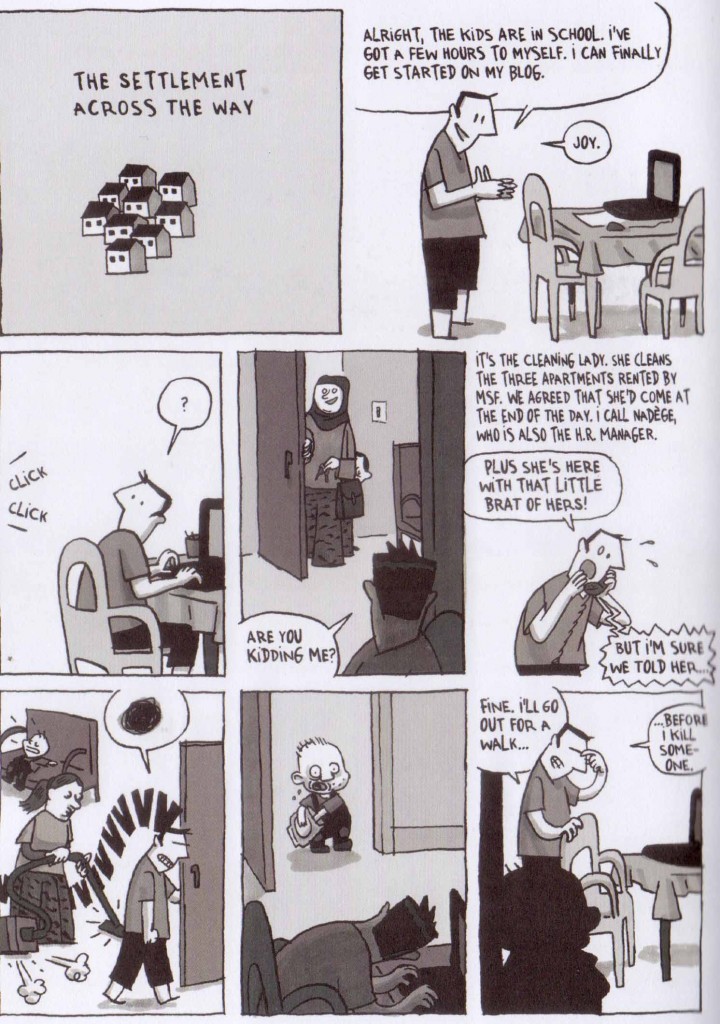

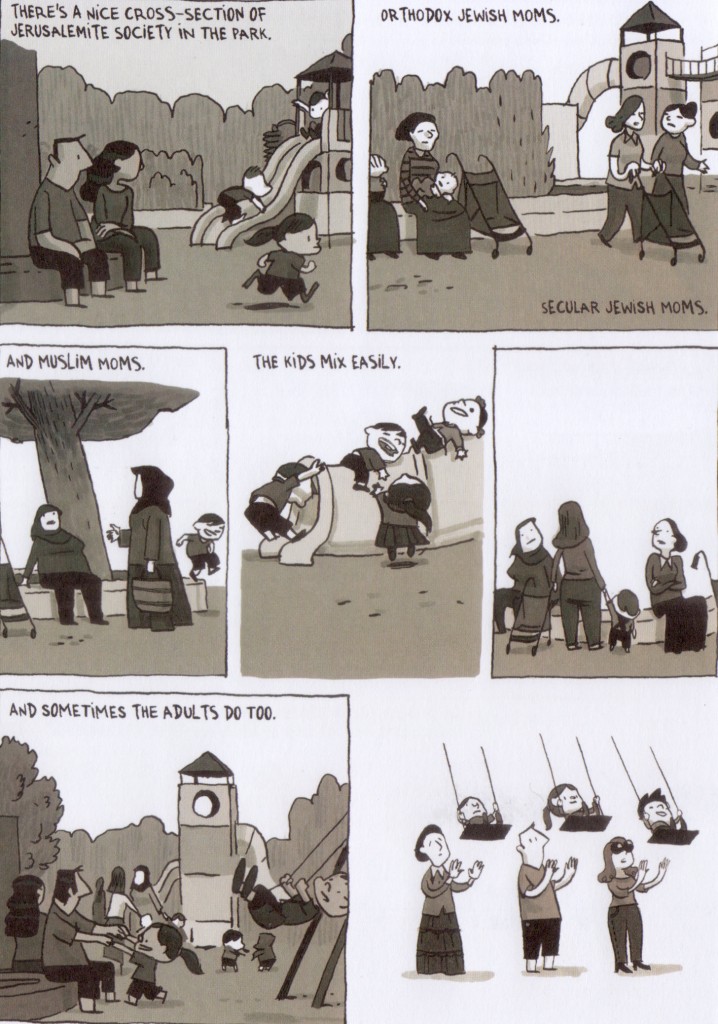
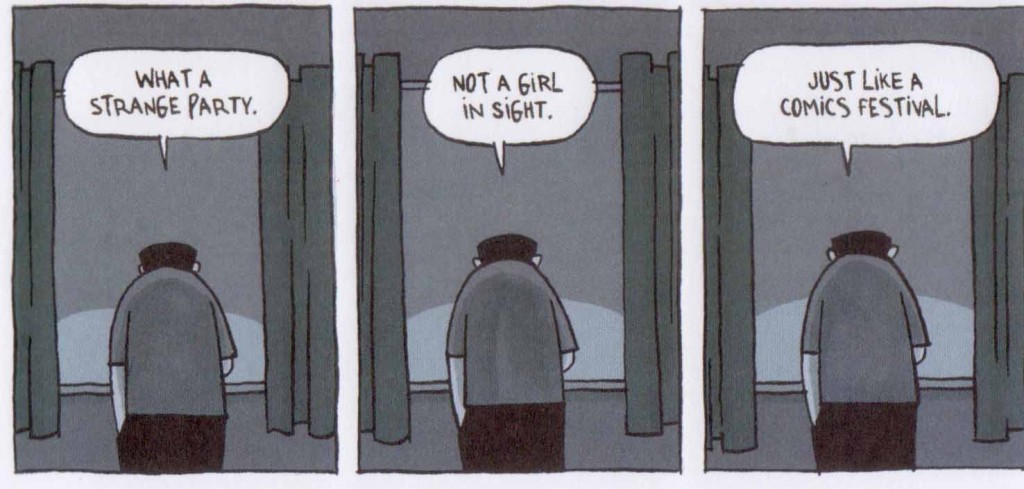
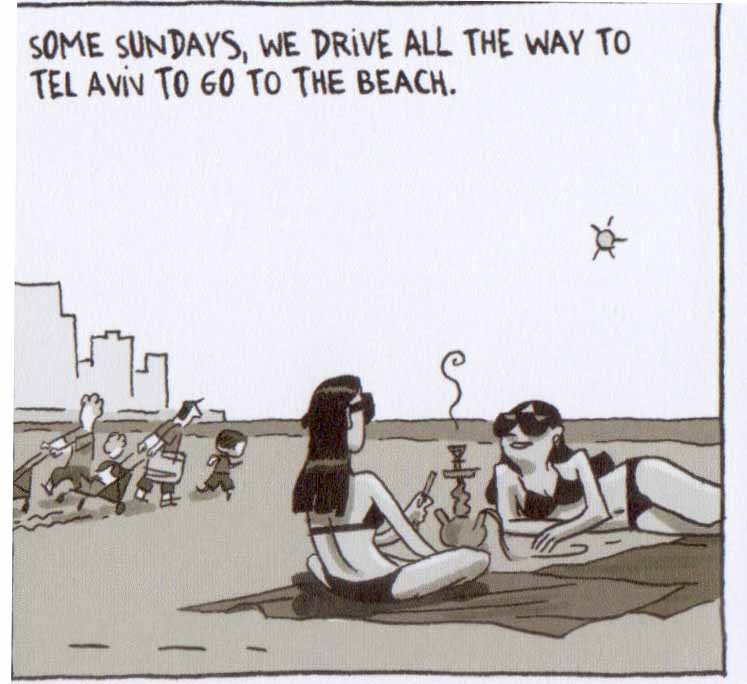
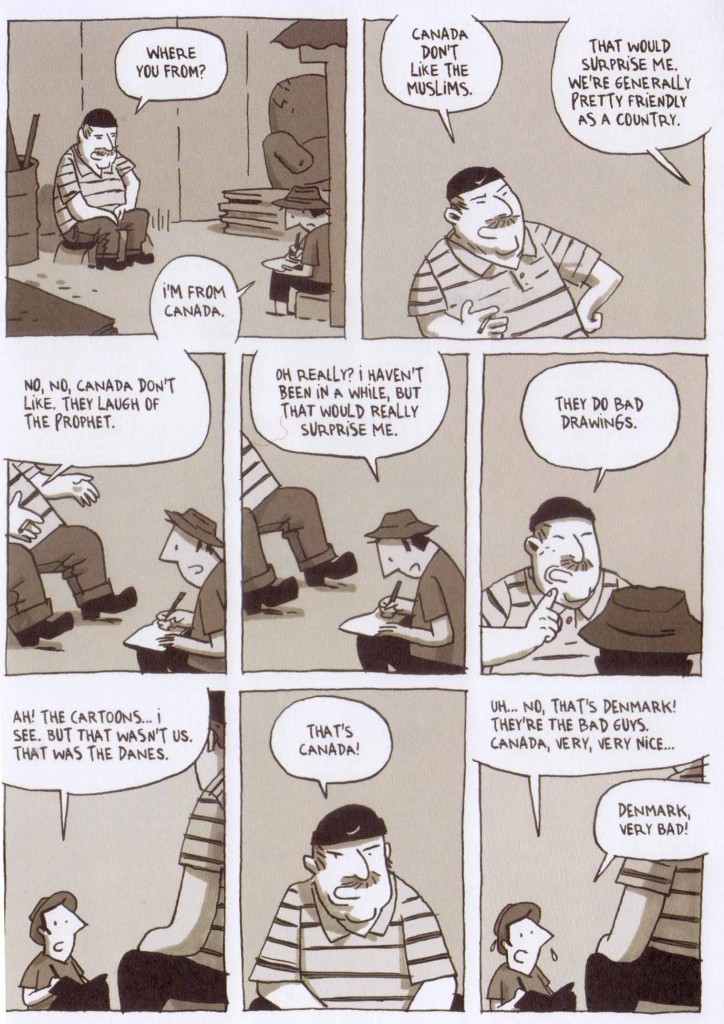
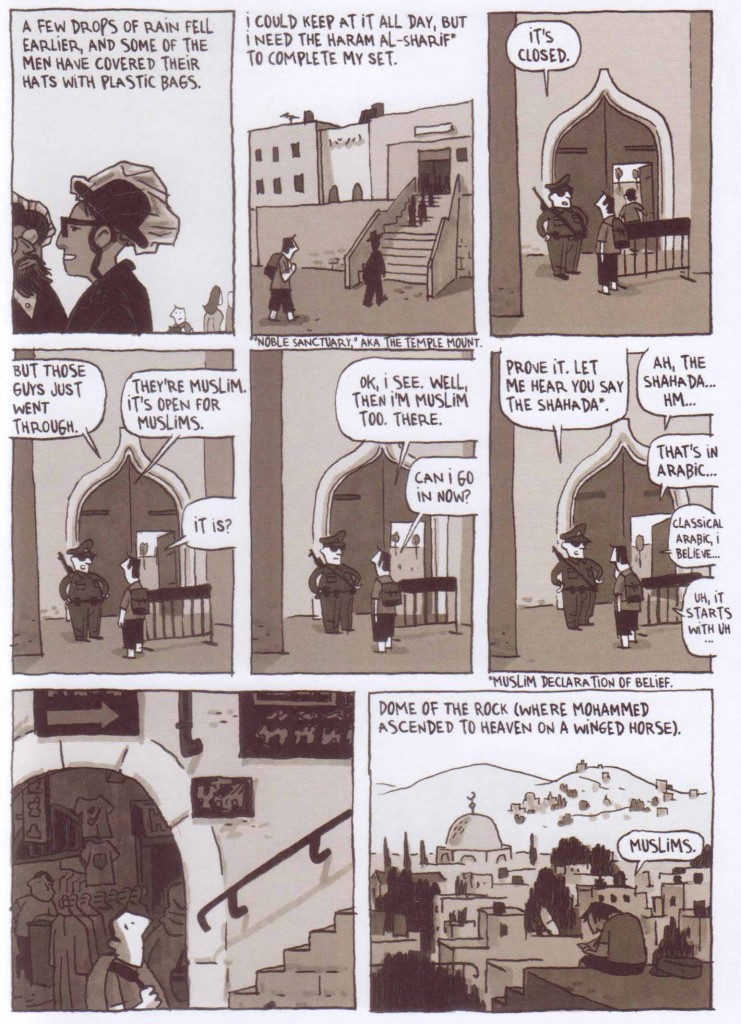
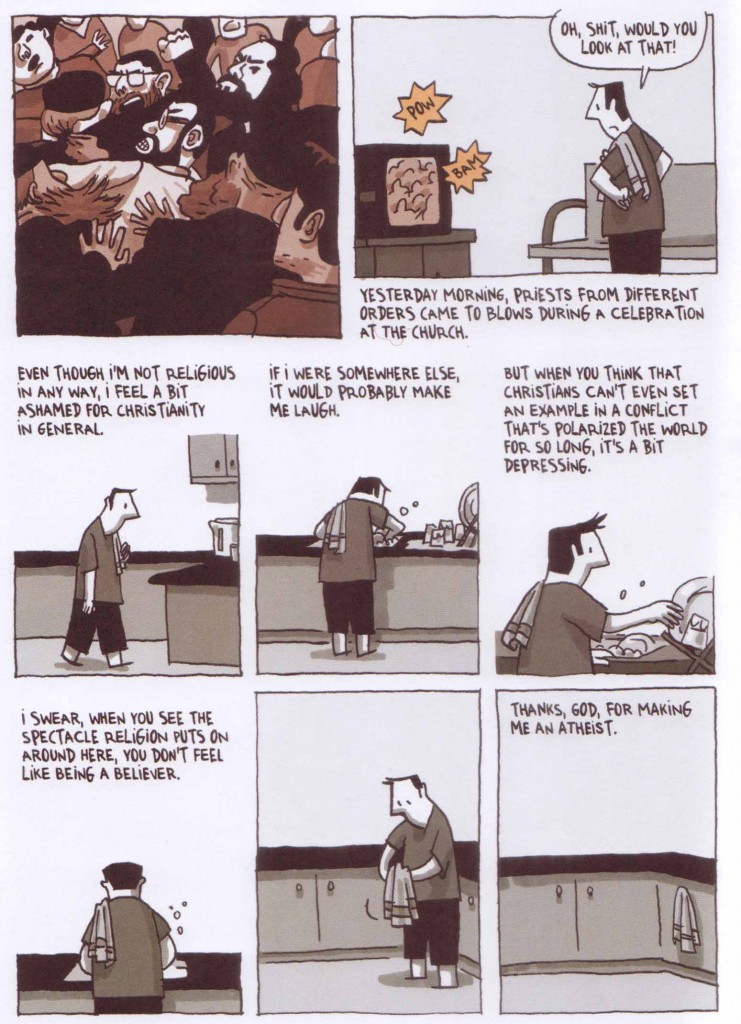
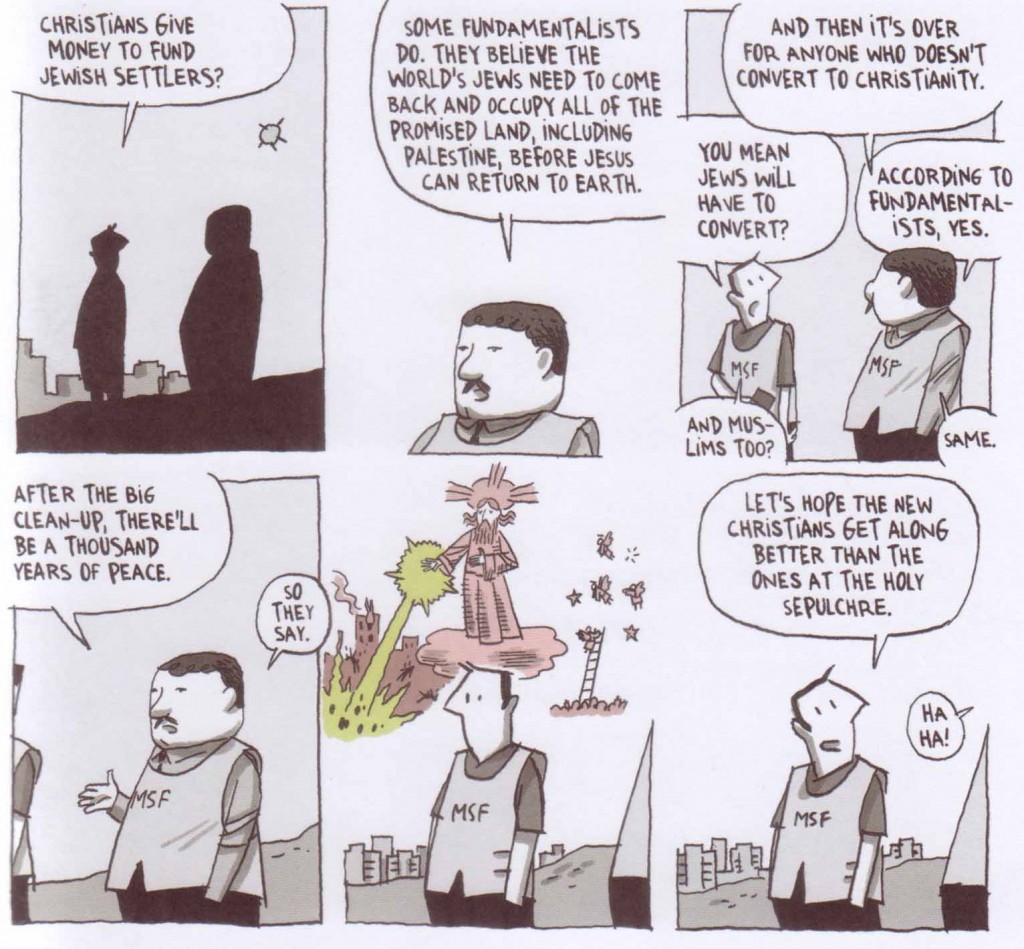

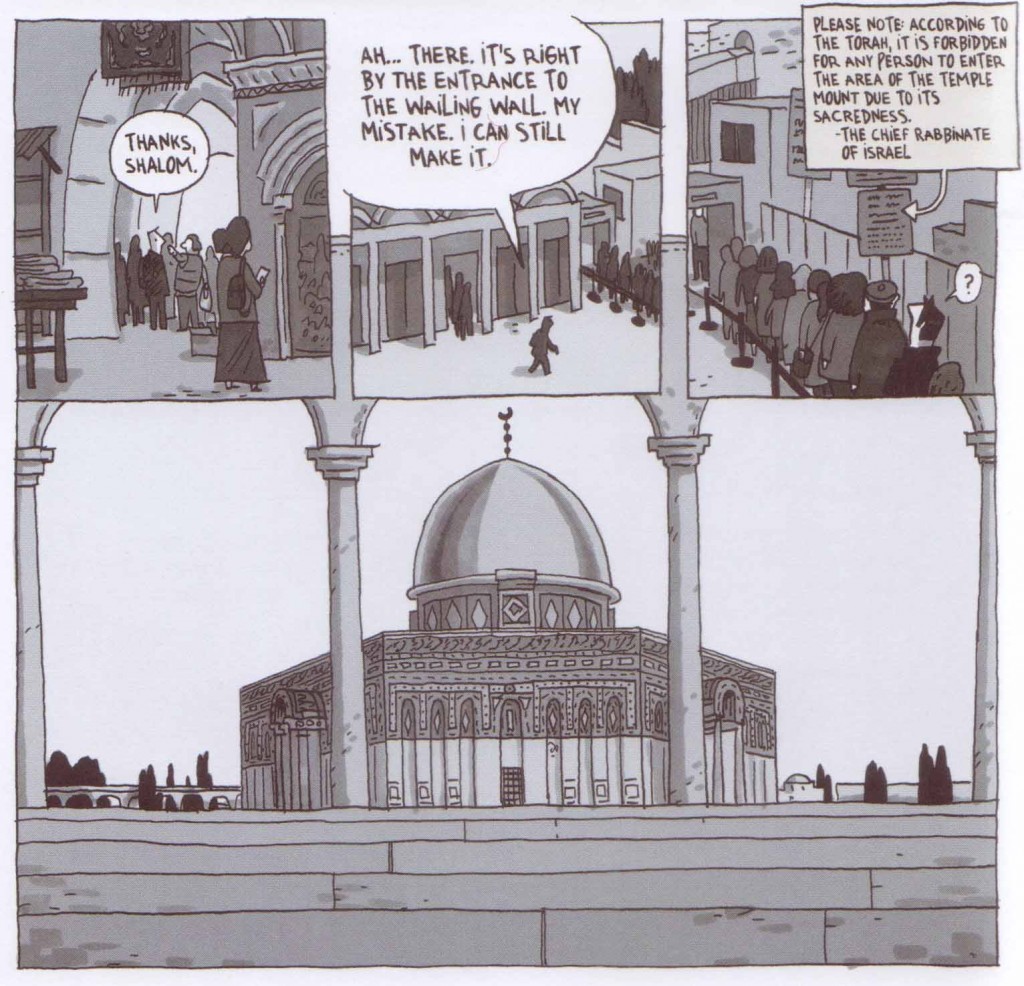
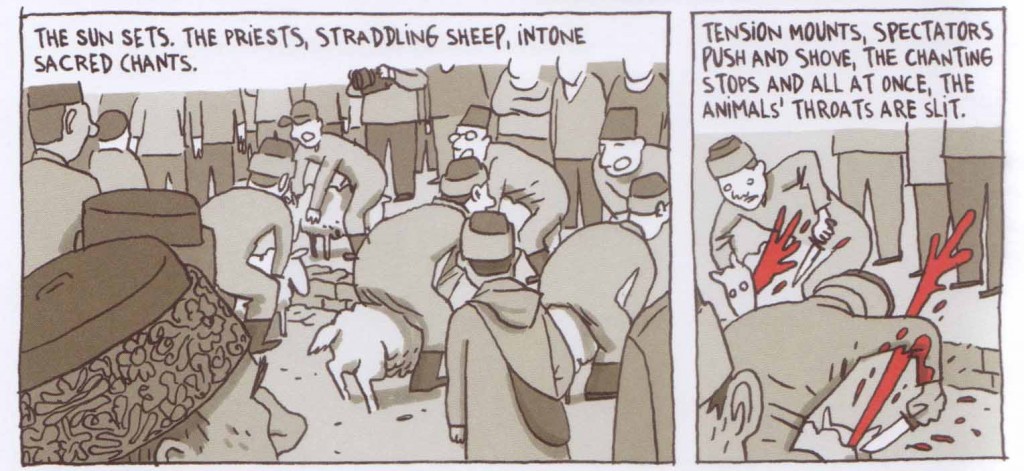
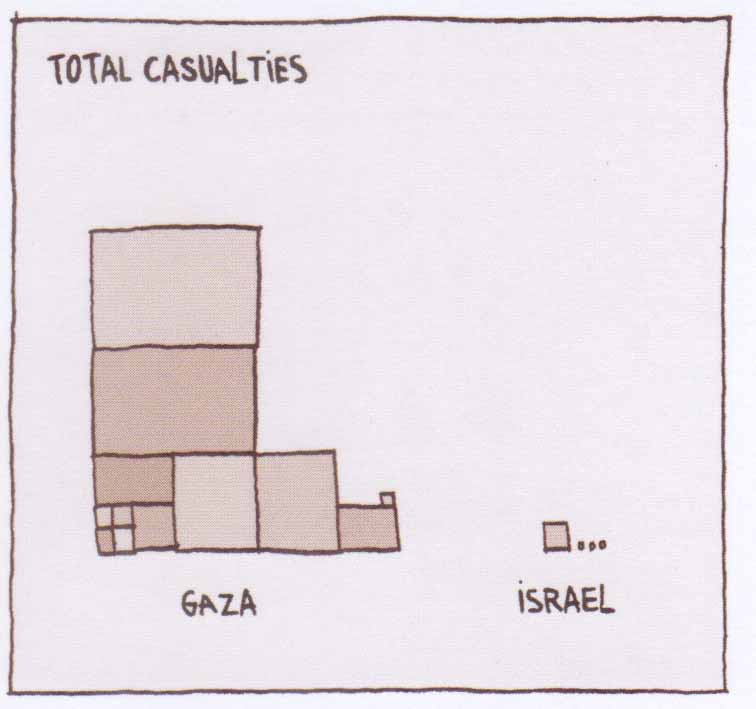
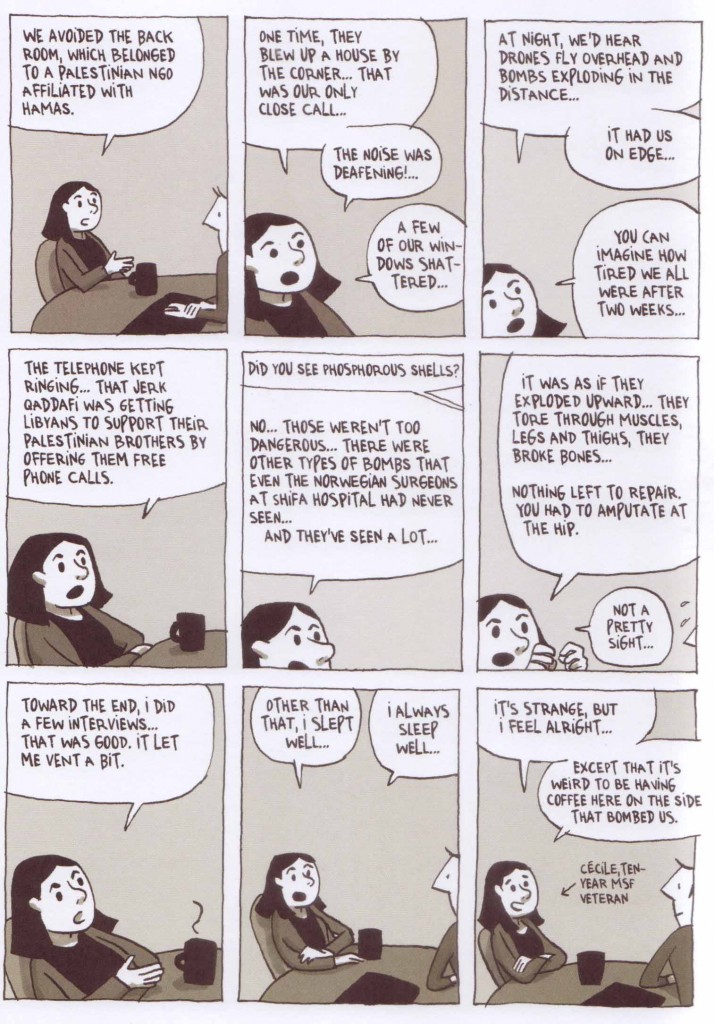
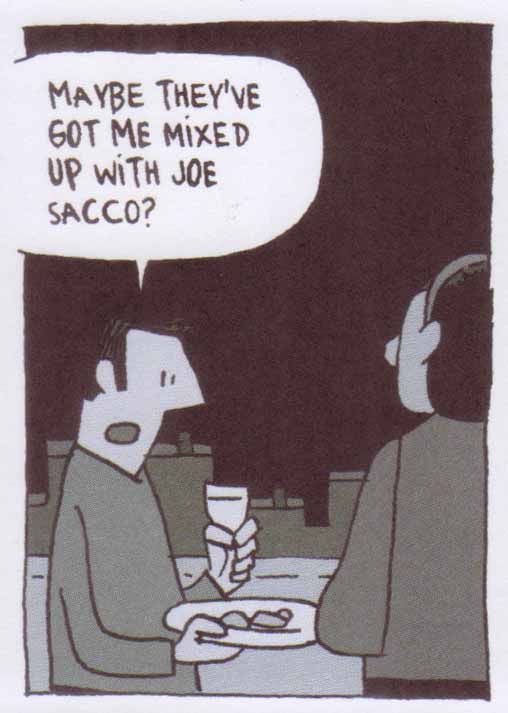
This is probably a dumb question, but who exactly is the market for this kind of book? I’m looking at it, and I can’t imagine why anyone would want to read it, let alone spend money on it.
Autobio comics often leave me asking this question….
I think it’s kind of the same appeal for liberal atheists as posting some news story that confirms your opinions on facebook and having all your friends who agree with you chiming in to say they agree with you. (Not that that’s solely a liberal impulse or anything.) It’s preaching to the converted in a mildly aesthetic, mildly educational vein that maybe makes it seem more valid or worthwhile than just signing up for a facebook account.
Or I guess it’s possible somebody likes the art? I can’t really imagine that myself, but anything’s possible….
Suat, is his North Korea book better? I feel like at least I’d learn something about North Korea if I read that; Israel is so well covered that the whole exercise just seems superfluous.
Ah…rereading saw that you did like Pyongyang at least a little better…
Richard: I do believe Jerusalem has become his best selling book and a number of people seem to like it. Even people who have lived for quite some time in Israel and are quite familiar with the place. It’s not so hard imagining someone who prefers this gentle, non-confrontational, middle-of the-road approach to travel writing. And there are definitely people who like the art. “Preaching to the converted” is probably correct. Just don’t read it for knowledge.
I think the Pyongyang book seems better because the level of ignorance on display is perfectly in sync with the regime’s efforts to control information. That and the fact that very few people travel to North Korea so even the view from the “tour bus” seems novel. It’s not a memorable comic in any way though.
I personally loathed the North Korea book, which largely seems to be comprised of Delisle having contempt for everyday North Koreans for having the misfortune to live in a brutal dictatorship. That combined with the art-and-writing level problems that Ng Suat Tong elucidates here made me uninterested in returning to that particular well.
That said– and I know that nothing can convince you otherwise– there’s a LOT more going on in, say, Joe Sacco than what you’ve articulated here, Noah. Regardless of how you feel about the Israeli-Palestinian conflict, Footnotes In Gaza assays important questions about how history is formed, how the truth is determined, what exactly “balance” might mean in this day and age and what the very project of journalism does to the psyches and souls of both subject and reporter. (I also happen to find the art masterful). He also stuffs some fairly interesting formal stuff into that work. It’s about a lot more than searching for confirmation of one’s opinion. And, while I happen to agree with Sacco’s opinions on the Israeli-Palestinian conflict, I’ve also seen people’s opinions changed, deepened and altered by reading his work.
There’s also, of course, the large vein of nonfiction comics that aren’t about issues but are instead autobiographical in nature. I don’t think Alison Bechdel’s “Fun Home,” for example, is solely of value because it takes it as a given that gay lives are worthwhile subject matter.
Point taken. A “gentle, non-confrontational, middle-of-the-road approach to travel writing” sounds very Hollywood-ish.
The first sentence of my comment may have thrown things off a little; my explanation of why people read Jerusalem was focused particularly on Jerusalem, not as a sweeping condemnation of all autobio comics.
I haven’t read Joe Sacco…so maybe I’d be convinced of its worth if I read it! I’m not really a fan of Fun Home…but I can see why people would read it without that much trouble.
Richard: Very Hollywood-ish but more observant than Samantha Brown (?)
Isaac: That’s an interesting view of Delisle and his approach to the common citizens of North Korea. Very similar to what S. I. Rosenbaum writes in her review of Jerusalem and his interactions with the Palestinians. His short quippy delivery can certainly give that impression but it’s quite possible that he’s totally unsuited to serious political discourse. Maybe that’s the only way he can process it as a cartoonist.
Also, what do you mean when you write: “…what exactly “balance” might mean in this day and age…” I’ve forgotten quite a bit of Footnotes in Gaza but I vaguely remember Sacco saying in interviews that he’s not terribly interested in balance. His comics seem to bear this out and are usually on the more emotional end of the spectrum as far as liberal reporting on Palestinian issues is concerned – closely zoomed in human cost stories. It’s certainly his niche since the big picture discussions teasing out solutions and mainstream media lies/fabrications are largely the province of alternative political sites and (maybe) aren’t as suited to the comics form.
Ng.
I actually mistyped in that sentence in a moment of pre-coffee aphasia. I meant “accuracy.” I was thinking in particular of the ways he starts cross referencing the interviews to find out what “really” happened, with the scare quotes around “really” being part of the book’s whole point. To me, Sacco’s work is a lot like Errol Morris’s, nonfiction work that formally inquires into the nature of nonfiction storytelling while also being good nonfiction storytelling.
I think if Delisle is ill-suited to serious political discourse… what’s the point of publishing his travelogues through places like North Korea, Burma and Jerusalem? I really don’t understand it. It’s like reading Tintin if Tintin were about actually trying (and failing) to be a journalist rather than seeking out hidden treasures with drunk sea captains.
Shit, also in the annals of mistyping, I should’ve addressed the above to “Suat” not “Ng.” Apologies.
—————————
Noah Berlatsky says:
…I haven’t read Joe Sacco…so maybe I’d be convinced of its worth if I read it!
—————————-
(!!!!) I never cease to be amazed at all the famous, “essential” works you haven’t read. (Like “Carmilla,” for Pete’s sake…)
Sacco’s utterly brilliant; he brings cartooniness and documentary detail, observation of the banality of everyday life and historic perspective, powerful realities, Art…
About Sacco: http://www.guardian.co.uk/books/2009/nov/22/joe-sacco-interview-rachel-cooke
Interviews with Sacco: http://www.comicsreporter.com/index.php/cr_holiday_interview_1_joe_sacco/
http://www.aljazeera.com/focus/2010/01/201011783113578937.html
Some Sacco pages:
http://goodokbad.com/assets/images/books/footnotes_01a.jpg
http://shalomrav.files.wordpress.com/2010/10/footnotes_in_gaza_.jpg
http://www.niemanstoryboard.org/wp-content/uploads/2009/11/sacco-cairo.JPG
http://thefunambulistdotnet.files.wordpress.com/2011/04/joe-sacco-the-fixer001.jpg (War-ravaged Sarajevo)
http://www.worldwar3illustrated.org/36/complacency.png
On a lighter vein: http://www.nytimes.com/interactive/2010/08/15/books/review/15sacco.html
If you’re going to read some Sacco, I’d recommend starting with “the Fixer”–the smaller scale acts as a good introduction IMO.
Why did I buy this? I was only mildly entertained by the Korean adventure, so didn’t expect much. I hadn’t bought a comic in ages, so I chose Jerusalem and Crossed. I read the latter and still haven’t looked at the former. Probably not the target audience.
Well…the secret truth is that I have read a Sacco short story or two, which is why I haven’t read anything else. I could try again though….
Richard: “This is probably a dumb question, but who exactly is the market for this kind of book? I’m looking at it, and I can’t imagine why anyone would want to read it, let alone spend money on it.”
I ask myself the same question about superhero comics and, then, it hits me…
I think it’s possible to hate both Guy Delisle and superhero comics. I don’t see why we have to limit ourselves.
It’s easy to get fooled into buying the comic though: good advance word and after release, a majority of positive reviews. #1 on the NYT GN bestseller list, some foreign awards I do believe. And the concept doesn’t completely stink. A comic about a year in Jerusalem by a cartoonist whose wife is working for MSF. How bad can it get? Only as bad/good as War Photographer?
But…what kind of a Sacco story? His stuff in his first comic, “Yahoo,” was as different from his reporting-type work as can be…
Even the latter varies; his tale of traveling with a touring rock band with a different approach from his grim stories of “ethnic cleansing”…
Mike, the one I remember was in reportage mode…dropping bombs and human rights violations, or some such. It did nothing for me; I don’t really like Noam Chomsky, and Noam Chomsky with indifferent art is not necessarily an improvement. But…like I said, maybe something else would work better. I may well give him another try at some point.
Care to explain why you don’t like Chomsky? Sacco isn’t that much like Chomsky in my opinion. The broad concerns are similar but there it ends.
Hooded Unitarian: “I think it’s kind of the same appeal for liberal atheists as posting some news story that confirms your opinions on facebook and having all your friends who agree with you chiming in to say they agree with you.”
As a liberal atheist, I declare here and now that I would contribute a substantial sum of money to a Kickstarter fund that would send Jack T. Chick and Fred Carter on a graphic novel tour through [gay hotspots of] Jerusalem.
I think sending Chick to the Holy Sepulchre church would be sufficient to get him going. You’d get the usual spiel about Catholicism as the Whore of Babylon.
Suat, I have the same problems with Chomsky as with Howard Zinn, basically. Dull, simplistic, agitprop. I agree with a lot of the conclusions, but reading it makes me almost wish I didn’t.
I’ve read the article but Chomsky isn’t always that one sided, is he? His take on Kosovo (online & reprinted in A New Generation Draws the Line) seems to engage with some of the alternative thinking out there. Could be construed as boring I suppose.
Noah,
I’m pretty sure the one you’re talking about is a *very* early short piece collected in a post-fame B-sides-type deal called “Notes From a Defeatist.” No wonder you haven’t wanted to check out more of his stuff if that is the case. The material in that book isn’t very good. It’s his first attempt at any kind of political or war-related writing and…well… it’s kinda bad. The post-Crumb band tour stuff in there is kind of fun but like most B-sides collections, it really is for fans only. It’s the only book of his I’ve never owned, actually.
The later work after he finds his style is much, much better and “Footnotes In Gaza” is, I think, one of the best comics of the last ten years. My entry point– most people’s, I think– is “Palestine.” Of the shorter works, “The Fixer” and the two stories collected in “War’s End” are both quite good. If you’re sick of reading about the Palestinian conflict, “Safe Area Gorazde” (about the Bosnian War) is also quite good.
“Palestine” is, to be fair, SOMEWHAT agit propish even tho I love it. Part of the point of it was to deliberately provide a counter narrative for American readers to what they were getting in the news. But the material where he’s focusing on people’s stories is amazing.
I’ve periodically nagged Noah to read Sacco and write an article on him for the last 1-2 years. Mainly because I want to read someone with a more radical take on Sacco. It doesn’t seem to have worked so far. Unless I’m mistaken, Footnotes in Gaza was rather poorly covered (in terms of review quality) by the comics press considering the stature of the author.
—————————–
Ng Suat Tong says:
I think sending Chick to the Holy Sepulchre church would be sufficient to get him going. You’d get the usual spiel about Catholicism as the Whore of Babylon.
——————————
Heh! As they say, even a broken clock tells the right time twice a day! Kudos to Chick for his Catholic Church-bashing… (In other words, anybody who says the Pope is the Antichrist can’t be all bad…)
——————————–
Noah Berlatsky says:
… the [Sacco story] I remember was in reportage mode…dropping bombs and human rights violations, or some such. It did nothing for me; I don’t really like Noam Chomsky, and Noam Chomsky with indifferent art is not necessarily an improvement.
——————————-
Many of his reportage stories are commissioned by magazines, and come with a limited page-count. With less room to spare, Sacco would thus be constrained in what he could cover (like the “other side’s” viewpoint), be less able to insert bravura but inefficiently info-conveying touches like:
http://thefunambulistdotnet.files.wordpress.com/2011/04/joe-sacco-the-fixer001.jpg (War-ravaged Sarajevo)
and http://www.niemanstoryboard.org/wp-content/uploads/2009/11/sacco-cairo.JPG …
——————————–
…I have the same problems with Chomsky as with Howard Zinn, basically. Dull, simplistic, agitprop. I agree with a lot of the conclusions, but reading it makes me almost wish I didn’t.
———————————–
I love Chomsky’s surgically precise, thoroughly-documented exposures of the rotten underbelly of the meretricious malarkey Americans hold sacred. (Amusingly, the most angry reaction he ever got was from a piece he wrote attacking pro sports!) But light n’ lively reading, it’s not…
———————————-
isaac says:
…My entry point– most people’s, I think– is “Palestine.”…
———————————-
Certainly his most substantial first masterwork! (I loved his early, light stuff, though, where the cartooning chops and touches that liven serious tales in spots were more prevalent. Like his “Yahoo” story of being a public librarian; with info-demanding jerks intimidating the reference librarians with “I’m a taxpayer, and…”, the reader-neglected “stacks,” wherein the classics reside, depicted as an alligator-infested swamp; masses grabbing for the multiple copies of Elizabeth Taylor’s “latest diet book”…
———————————-
“Palestine” is, to be fair, SOMEWHAT agit propish even tho I love it. Part of the point of it was to deliberately provide a counter narrative for American readers to what they were getting in the news. But the material where he’s focusing on people’s stories is amazing.
————————————-
“Yes” to all that. Those who attack it for not giving “equal time” to the Israeli side leaving out the little detail that virtually all the “liberal media” gives us is the Israeli side.
(A Chomsky masterpiece comes to mind here: “Manufacturing Consent”: http://en.wikipedia.org/wiki/Manufacturing_Consent:_The_Political_Economy_of_the_Mass_Media .)
And Sacco doesn’t demonize Israelis, nor does he excuse all that some Palestinians do. But, reading what they’ve had to put up with, no wonder they hate Israel!
“(In other words, anybody who says the Pope is the Antichrist can’t be all bad…”
Mike, you really, really need to rethink that, please. Anti-Catholicism has inspired its share of massacres, just like any other hateful prejudice. In addition, while there is a lot wrong with the Catholic church, to put it mildly, it is also one of the (if not actually the) largest philanthropic organizations in the world, not to mention one of the few that consistently opposes imperial adventures (like the U.S. in Iraq, for starters.)
This sort of frankly scurrilous, blinkered, prejudiced nonsense makes me take your recommendations for political art (or for anything) with a large grain of salt. And it’s also just noxious. Really, think before you say this shit.
And no, we’re not going to have a debate about whether Jack Chick’s take on the Catholic Church as the whore of babylon is justified, just like we’re not going to have a debate on whether the Nazis had a point about the Jews. I’ll delete anything that starts to go there.
Yeah, ’cause I make a smartass remark “approving” of Jack (“Halloween and Dungeons & Dragons leads to Satanism”) Chicks’s view of the Catholic Church…
…that means everything I say can be dismissed; that I’m utterly unaware of all the good the Catholic Church has done. (To which one can add, keeping the flame of civilization alive and preserving ancient learning through the Dark Ages, funding some of the greatest art and architecture the world will ever see, serving as a societally-cohesive force after the fall of the Roman Empire.)
For the record (stop the presses!), no, I don’t think the Pope is the Antichrist.
But if an institution is going to make a habit of literally “demonizing” the opposition, it’s only predictable that some will be amused (the horror!) if some right-wing nutjob calls their top dude a tool of Satan.
Fair enough, Mike. It can sometimes be a little unclear to what extent one’s joking on the internets.
Noah, concerning the Pope as Antichrist…I think you would be interested by this review in the New Yorker:
http://www.newyorker.com/arts/critics/books/2012/03/05/120305crbo_books_gopnik
And being anti-Pope isn’t to be confused with being anti-Catholic. Both of which I am, for good reason, having been raised, baptized and confirmed in the faith.
That’s a really enjoyable piece, Alex; thanks for the link.
“Suat, I have the same problems with Chomsky as with Howard Zinn, basically. Dull, simplistic, agitprop”
It’s all in the voice. At least he reads his own words quite well. Maybe he should read comic book readings….
Sounds like the Sacco story Noah dislikes is “When Good Bombs Happen to Bad People.” Definetly not anywhere near his best. Much better is his anti-Gulf War stories from “Notes from a Defeatist” as well as his stories covering a touring garage band in Europe.
It would be interesting to see what flaws Noah would find in “Palestine” or “Footnotes,” if only to challenge the overwhelming praise those books have received. I find it very hard to find any fault with them…..
“Maybe he should do comic book readings….” Grrr….
Oh, and “The Fixer” is lesser Sacco, at least artwise. He clearly was less meticulous with that story. “Palestine,” “Safe Area,” “Footnotes” and parts of “Notes from a Defeatist” are safer bets.
I didn’t think Delisle was being condescending to the North Koreans in that book. He was as affectless there as he’s been in all his other books. It works with the absurdities of the place. In other books, though, his content-free wallpaper-approach is as bland as a Ziggy comic strip.
Well, I guess I prefer the less meticulous Sacco then… it definitely doesn’t feel quite as, er, labored as some of his pages. And the way the narrative unfolds is also fairly loose. Love the Fixer.
Also, so much dislike of Pyong Yang? It doesn’t strike me as a condescending book, rather a bewildered one. And agree that it seems a place particularly well-suited to Desile’s art.
It’s very effortless to find out any matter on net as compared to textbooks, as I found this piece of writing
at this website.